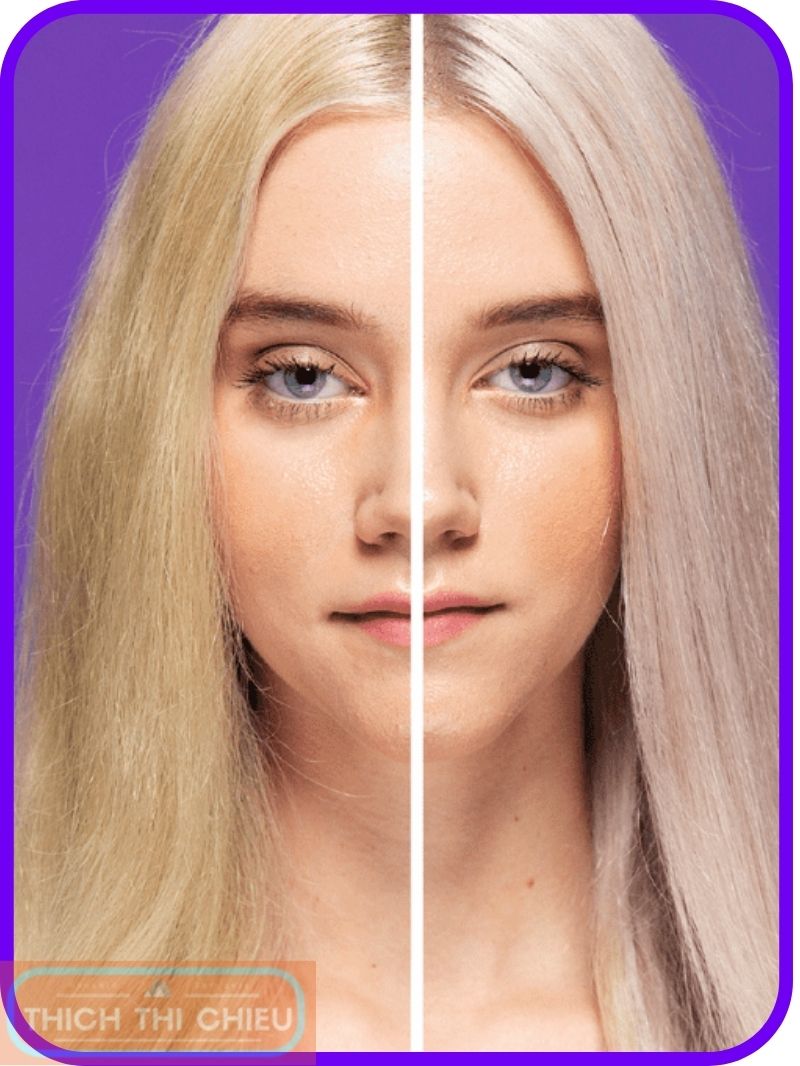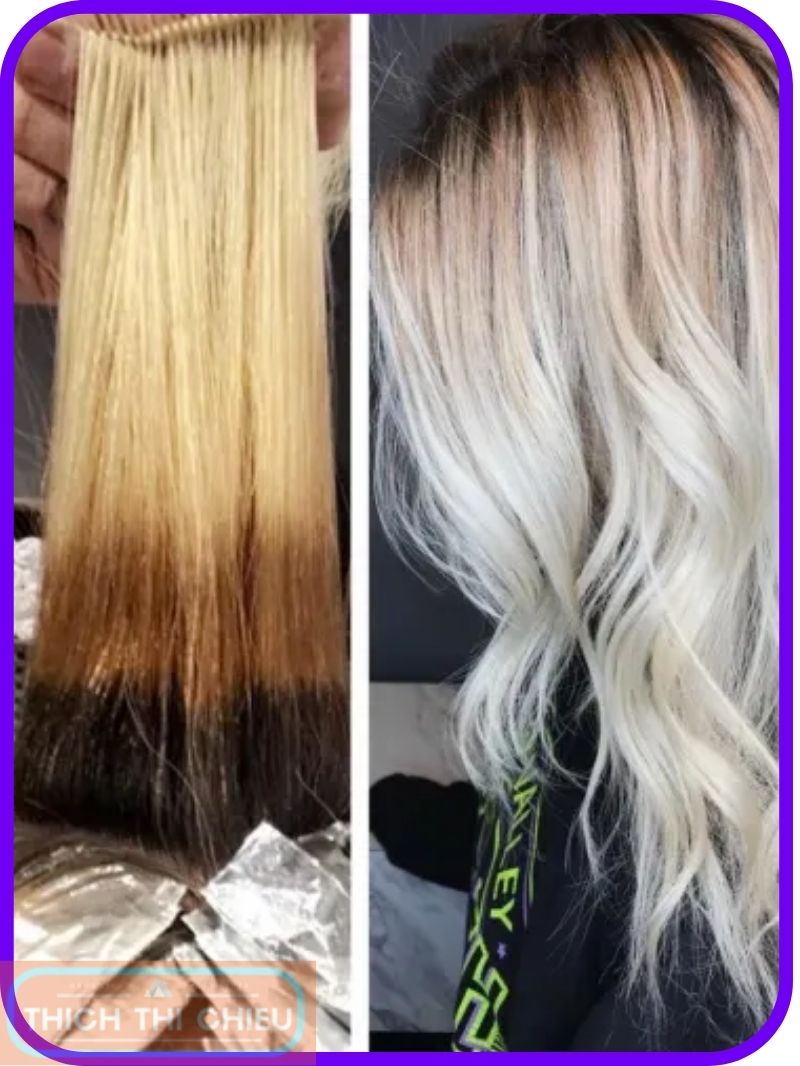Hair color correction is the process of fixing a hair color that has gone wrong. This can include anything from fixing brassy highlights to correcting a botched at-home dye job. Hair color correction can be a complex process, and it is important to see a qualified stylist to ensure that your hair is not damaged.
There are many reasons why people might need hair color correction. Some of the most common reasons include:
- To fix an uneven hair color
- To get rid of brassiness
- To correct banding
- To lighten hair that is too dark
- To darken hair that is too light
Some of the most common hair color mistakes include:
- Uneven color: This can happen if the hair is not properly sectioned before dyeing, or if the dye is not applied evenly.
- Brassiness: This is a common problem for blonde and highlighted hair, and it is caused by the oxidation of the hair color.
- Banding: This is a visible line of demarcation between two different hair colors. It can happen if the hair is not properly bleached before dyeing, or if the wrong developer is used.
- Too dark: This is a common mistake for people who are trying to dye their hair darker at home. It is important to choose a dye that is only one or two shades darker than your natural hair color.
- Too light: This is a common mistake for people who are trying to dye their hair lighter at home. It is important to bleach your hair gradually, and to use a toner to neutralize any unwanted brassy tones.
If you have made a hair color mistake, or if you are thinking about getting hair color correction, I recommend reading this article to learn more about the process and what to expect.
How to fix a hair color mistake
Uneven color
If your hair color is uneven, the best thing to do is to see a qualified stylist. They will be able to assess the damage and recommend the best course of action.
Here are some tips for fixing uneven hair color:
- Use a toner: A toner can help to even out the color of your hair and neutralize any unwanted tones.
- Dye your hair again: If the toner does not work, you may need to dye your hair again. Be sure to choose a dye that is the same color as your desired hair color.
- Get a haircut: A haircut can help to remove any split ends and give your hair a fresh, even look.
Brassiness
Brassiness is a common problem for blonde and highlighted hair. It is caused by the oxidation of the hair color.
Here are some tips for fixing brassiness:
- Use a purple shampoo: A purple shampoo can help to neutralize brassy tones.
- Use a toner: A toner can also help to neutralize brassy tones and even out the color of your hair.
- Get a gloss: A gloss can help to add shine and dimension to your hair and reduce the appearance of brassiness.
Banding
Banding is a visible line of demarcation between two different hair colors. It can happen if the hair is not properly bleached before dyeing, or if the wrong developer is used.
Here are some tips for fixing banding:
- Get your hair bleached again: The best way to fix banding is to get your hair bleached again. This should be done by a qualified stylist to avoid further damage.
- Use a toner: A toner can also help to blend the two different hair colors and reduce the appearance of banding.
Too dark
If your hair is too dark, the best thing to do is to see a qualified stylist. They will be able to assess the damage and recommend the best course of action.
Here are some tips for fixing hair that is too dark:
- Use a color remover: A color remover can help to remove the dye from your hair and lighten it.
- Get your hair bleached: If the color remover does not work, you may need to get your hair bleached. This should be done by a qualified stylist to avoid further damage.
Too light
If your hair is too light, the best thing to do is to see a qualified stylist. They will be able to assess the damage and recommend the best course of action.
Here are some tips for fixing hair that is too light:
- Use a toner: A toner can help to darken your hair and neutralize any unwanted tones.
- Dye your hair again: If the toner does not work, you may need to dye your hair again. Be sure to choose a dye that is one or two shades darker than your desired hair color.
It is important to note that fixing a hair color mistake can be a complex process, and it is important to see a qualified stylist to ensure that your hair is not damaged.
How to prevent hair color mistakes
Do your research
Before you dye your hair, take some time to research different hair colors and techniques. You can also ask your stylist for advice.
Here are some things to consider when choosing a hair color:
- Your skin tone: Some hair colors look better on certain skin tones than others.
- Your eye color: Some hair colors can enhance your eye color.
- Your hair type: Your hair type will affect how the color takes to your hair and how long it lasts.
- Your desired look: What kind of look are you going for? Do you want a subtle change or a dramatic transformation?
Use high-quality products
When you are dyeing your hair at home, be sure to use high-quality products. This will help to minimize the risk of damage.
Here are some tips for choosing high-quality hair dye products:
- Look for products that are specifically designed for your hair type.
- Avoid products that contain harsh chemicals.
- Choose products that are color-safe.
Follow the instructions carefully
Be sure to follow the instructions on the hair dye box carefully. Do not over-process your hair, as this can lead to damage.
Here are some tips for following the instructions carefully:
- Read the instructions carefully before you start dyeing your hair.
- Do a strand test to make sure that you are happy with the color before you dye your entire head of hair.
- Do not leave the dye on your hair for longer than the recommended amount of time.
Get regular trims
Getting regular trims will help to remove split ends and keep your hair healthy. This will make it easier to dye your hair and achieve the desired results.
Here are some tips for getting regular trims:
- Get your hair trimmed every 6-8 weeks.
- Tell your stylist that you are planning to dye your hair so that they can give you a trim that will help to achieve the desired results.
Hair color correction aftercare
After you have had your hair color corrected, it is important to follow a few simple aftercare tips to help protect your hair and maintain the desired color.
Use a color-safe shampoo and conditioner
A color-safe shampoo and conditioner will help to prevent the color from fading. Look for products that are specifically designed for colored hair.
Avoid heat styling
Heat styling can damage your hair and cause the color to fade. If you must use heat styling tools, be sure to use a heat protectant spray first.
Get regular trims
Getting regular trims will help to remove split ends and keep your hair healthy. This will make it easier to maintain the desired color.
Here are some additional tips for hair color correction aftercare:
- Avoid washing your hair too often. Washing your hair too often can strip the color and leave your hair looking dull and dry.
- Use a deep conditioning treatment once a week. This will help to keep your hair hydrated and prevent the color from fading.
- Avoid using chlorine pools and hot tubs. Chlorine and hot water can strip the color from your hair.
- Protect your hair from the sun. UV rays can damage your hair and cause the color to fade. When you are going to be in the sun, wear a hat or scarf to protect your hair.
Additional tips for hair color correction
- Consult with a stylist: Before you get hair color correction, it is important to consult with a qualified stylist. They will be able to assess your hair condition and recommend the best course of action.
- Be patient: Hair color correction can take multiple sessions to achieve the desired results. Be patient and trust your stylist.
- Be prepared to pay for hair color correction: Hair color correction can be a complex and time-consuming process. Be prepared to pay for the stylist’s time and expertise.
Here are some additional tips that may be helpful:
- Take photos of your desired hair color: This will help your stylist to understand what you are looking for.
- Be open to suggestions: Your stylist may have some suggestions for how to achieve your desired hair color. Be open to their suggestions and trust their expertise.
- Be prepared for the possibility of damage: Hair color correction can damage your hair, especially if it is done multiple times. Be prepared for the possibility of damage and be sure to follow your stylist’s aftercare instructions carefully.
Conclusion
Hair color correction can be a complex process, but it is important to see a qualified stylist to ensure that your hair is not damaged. By following the tips in this article, you can help to get the best possible results from your hair color correction.
Here are some key takeaways from this article:
- Hair color correction can be used to fix a variety of hair color mistakes, such as uneven color, brassiness, banding, hair that is too dark, and hair that is too light.
- It is important to see a qualified stylist for hair color correction to ensure that your hair is not damaged.
- There are a number of things you can do to prevent hair color mistakes, such as doing your research, using high-quality products, following the instructions carefully, and getting regular trims.
- It is important to follow your stylist’s aftercare instructions carefully after hair color correction to help protect your hair and maintain the desired color.
If you are considering hair color correction, I encourage you to consult with a qualified stylist to discuss your specific needs and goals.










Leave a Reply